METHODOLOGY FOR DEVELOPING AND INTERNALISING RHYTHM AND TIMING THROUGH BODY MOVEMENT
MOTIVATION
In most cultures, music-making is strongly connected with the ability to dance and sing. In many African countries, there is no differentiation between music and dance, as there is just one word describing both. A natural way of learning music is being thought by active listening and mirroring, rather than passive learning theory, ear training, etc. Through the last century in Western culture studying music became focused more on technique, finesse, and stylistic appropriation and distanced itself from the essential reasons for music making:
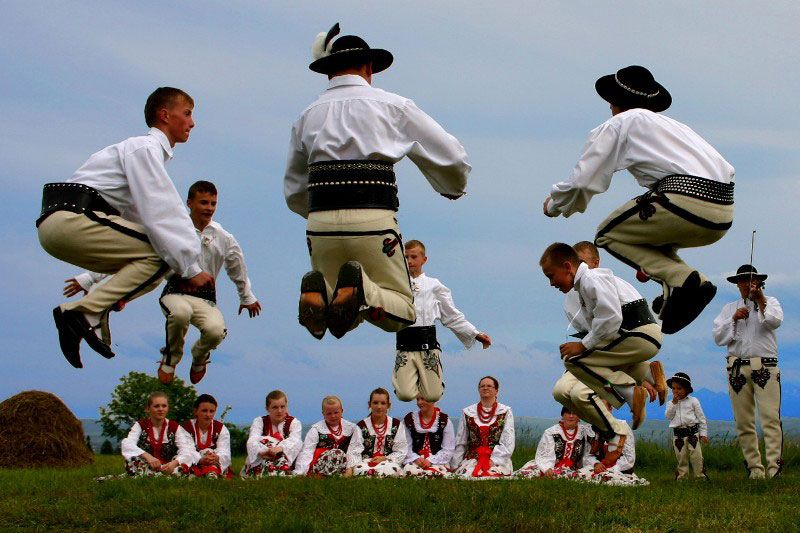

It is noticeable that students nowadays have adopted passive, often screen-bound habitat. The repercussions of decreased mobility can be seen in many aspects of music studying: from bad posture affecting the comfort of using instruments and quality of sound,

EXISTING METHODS
Drawing from our own experiences during our studies at various conservatoires in the past, talking to students as well as our peers and colleagues, we decided to search for methods used to improve timing and sense of rhythm through the use of body exercises. Our assumption that was based on these experiences and conversations was, that in most educational institutions such as ours, the methods used to work on timing and sense of rhythm would be similar and would have little to do with combining the practice of rhythm with the body movement. However, we discovered that at some of the institutions or outside of them, there are classes led by teachers and instructors that employ techniques that combine the practice of rhythm in various combinations and use body movement to a certain extent. Some methods use percussion instruments, sometimes combining rhythmic exercises with singing or body percussion (ion (Udo Dahmen, Kouame Sereba – Zikalo method, Peter Stavrum) other use entirely different concepts of approaching rhythm and timing (Jose Eduardo Eduardo Gramani – Ritmika). The Royal Conservatoire of Brussels has its own bachelor course devoted strictly to Rhythm and Rhythmics under supervision of Arnould Massart.
• UDO DAHMEN
For over 30 years Dahmen have been developing his own way of teaching timing and body percussion. “All my exercises are based on imagination, feel and movement. I believe that rhythm and timing are inseparable elements, one cannot exist without the other, and they are closely connected to heartbeat and the breath.”

Rhythm and Movement (standing or walking)
‘Campfire’, Vocassion (sitting and clapping or speaking)
Meditation (lying on the floor)
• KOUAME SEREBA
Sereba is a multi-instrumentalist and singer originally from Ivory Coast, based in Norway – uses body movement combined with percussion instruments and singing. He uses exercises that use the language he created, to express certain rhythms Ao-Ao, O Zim Zim, etc. This language is helping the students to perform rhythms and communicate when using Call-and-Response exercises.
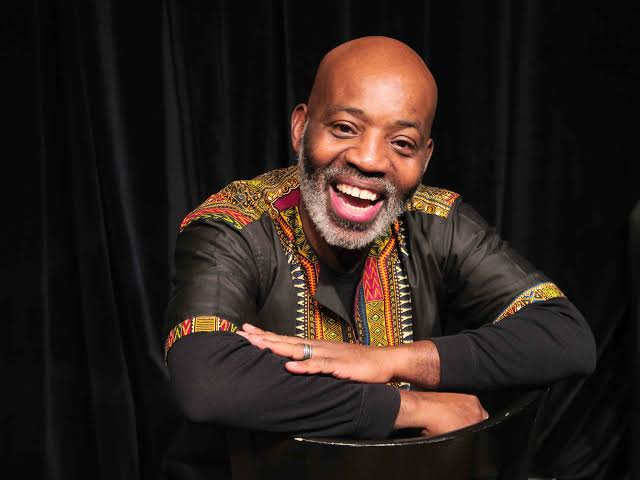
Sereba calls his method Zikalo, which translates as music where “everybody joins in”. According to him, this method is meant for everyone who is concerned about their well-being. Besides refining the sense of rhythm, it is designed to improve one’s state of mind and connectivity with body, releasing endorphins when engaged in the practice and thus “feeling happy”, deepening self-awareness and according to the research also have other health benefits. The content of the course is based on short exercises, sometimes just a certain movement or a rhythmic pattern that is repeated and eventually combined with other patterns played for several minutes at a time. It is engaging and playful, very accessible to anybody with or without any musical affiliation or background. It seems that Sereba’s course was inspired to a certain extend by the research [1] dealing with the effects of group drumming music therapy and the results of such a practice.
• PETER STAVRUM

Is a renowned body percussion specialist, former member of percussion group Stomp [2] , instructor at Rhythm Week in Helsinki 2014, The International Body music Festival in Paris 2016 & Body Rhythm Hamburg in 2019. His course is designed for anybody who would like to learn the techniques of body percussion and enjoy the sensation of rhythmic movement. Stavrum introduces the sounds that can be produced using these techniques and build exercises from simple to more advanced. He teaches various movements with feet and stamping, combining them with clapping and other sounds common to body percussion. There are pre-recorded tracks with the metronome and beats that help enhance the process. The course also teaches beats and grooves in various styles such as rock, funk, reggae, Latin, etc.
• JOSE EDUARDO GRAMANI – Ritmika
According to Gramani, rhythm is traditionally thought of and looked at purely mathematically in music education. That suggests that if you can add 2+2 etc., you should be able to play and understand rhythm. Gramani indicates that the reality of rhythm is very different. Looking at the rhythm only through mathematical relations undermine its importance and separates the musicality from the rhythm, creating a barrier between the perception of music and rhythm. The main goal of his teaching is trying to bring rhythm as a musical entity that is much closer to its full potential, making it a musical element that has not just arithmetic, but also perceptual relevance.
Gramani compares rhythm to harmony, where the relations between the voices are vertical. The rhythm is related directly to the time signatures and is often seen as a slave of the timing. For example, syncopated rhythm ta tam ta - ta tam ta, is often not executed well as a whole, but instead, accentuation is put predominantly on the down beats, etc. The idea he is presenting is seeing rhythm more contra punctual than harmonic. Although there is a vertical relation without which there wouldn’t be perfect measurement of duration, the rhythmical phrase is not subordinate of time. It happens trough-out time horizontally keeping its basic characteristics. For this to happen it is necessary that the musician activates a series of basic functions that are normally overlooked due to the studies consisting of repetition and automatization, and making this more intrinsically.
It is important for the musician to activate his/her capacity of concentration which wasn’t usually required for rhythm.
To be able to execute and feel rhythm horizontally like a counterpoint, happening simultaneously, this concentration is essential to change the attitude and approach towards executing rhythm making conscious decision into musical rhythm. Not treating the rhythm just as a side step as mathematics of the phrase, but consciously perform it as a music.
To achieve this goal of a new and more musical approach to rhythm, it is very important to create new associations. Creating more conscious approach in utilisation of movement, gestures, and attitude. We need to be fully aware of the performance of the rhythm.
The exercises that Gramani designed are focused on bringing up the “musical face” of rhythm. They are not the end goal but rather the means supporting the process for the development. When the exercises are performed well, they already served their purpose and we can move on to the next.
The exercises are made to be the vehicle for the reaching of the sensibility and understanding the relations making new associations.
Gramani is using singing and various rhythmical voices for singing, both hands, feet or using percussion instruments. If starting the exercises with one hand, it needs to be inverted and played in the other way as well. This is helping to create more awareness and freedom.
It is very important to perceive the individual voices as equal and not one more important than the other. In his description of the utilization of his exercises, Gramani uses the comparison to harmony versus counterpoint - each voice should be independent although they happen at the same time. Harmony, blocks of sounds and chords, have vertical relationships between the sounds and counterpoint has melodic independent lines.
• RHYTHM AND RHYTHMICS
The Royal Conservatoire of Brussels has the whole Bachelor course devoted to the subject of rhythm, timing, body percussion. Through the 3 years of education students learn variety of subjects from kinesthesia, anatomy, through dances from different parts of the world, body training, through ethnomusicology and therapeutic methods, to neuropsychology of rhythm. It’s a very complete course with very well thought curriculum.
SUMMARY:
All the resources that we found were very valuable in terms of establishing a direction of our research. The most useful in practical aspects were works of Peter Stavrum, because it was very relatable to what we concluded would be a good starting point at our lessons. It was also the most appealing visually with cleverly constructed videos. Our direct experience with Udo Dahmen’s work gave us idea how important body movement, and ability to combine several layers is. It also made us realise our own shortcomings. His work is quite advanced, as he is a drummer, and can be an inspiration for further development of our method.
Our goal is to gather the exercises and adjust them to the needs of our students based on their level and experience during our try-out sessions.
CASE STUDIES
Workshop/Case study with the choir: Before researching the subject of rhythm in connection to the body, we encountered many examples at the lessons, where working with rhythm brought an immediate improvement. Especially two cases, one during an individual voice lesson and the other, during the jazz choir class few years back. At the individual lesson singer couldn’t manage an improvisation on a difficult chord progression. When asked to walk around the room, snapping fingers to on 2 and 4, and focus only on singing/saying improvised rhythmic patterns based roughly on the swinging eight-notes, their sound immediately gained depth, harmonic information became more elaborate (although the focus was somewhere else), the whole body was activated, tension in the shoulders and jaws were released. Similarly, in second case, the jazz choir members during a warm-up were asked to follow the score of a traditional song from Botswana, written out in 12/8 time signature. It included drum part (that was replaced by stomping), clapping hands in certain pattern and singing in 4-part harmony. It was noticeable that most of the choir members couldn’t even manage clapping and stomping, so singing the actual melody was out of the question. We simplified the song to just clapping, while one person was stomping the rhythm and for about an hour, we were increasing difficulty adding stomping then singing the first few bars of melody line, then adding harmony. Everyone had their own pace, some students were further than other, there was no pressure to ‘finish the song’ on that day. By the end of the exercise students were clapping in a perfect unison and singing the basic pattern without difficulty. And they were visibly in better mood then at the beginning of the lesson.
On June the 10th 2022, we conducted a case study with conservatoire jazz choir members, mostly consisting of vocalists: 4 jazz vocalists, 1 classical vocalist, and 1 classical flutist. The objective was to try to determine the simplest exercises (more details about that are in chapter Exercises) to choose for a starting point, how many layers we can work with within the first lesson, how many exercises we can successfully introduce and perform within the time frame given as well as an observation of how everyone is dealing with them and reacting to it. Part of the case study was a survey introducing these questions:
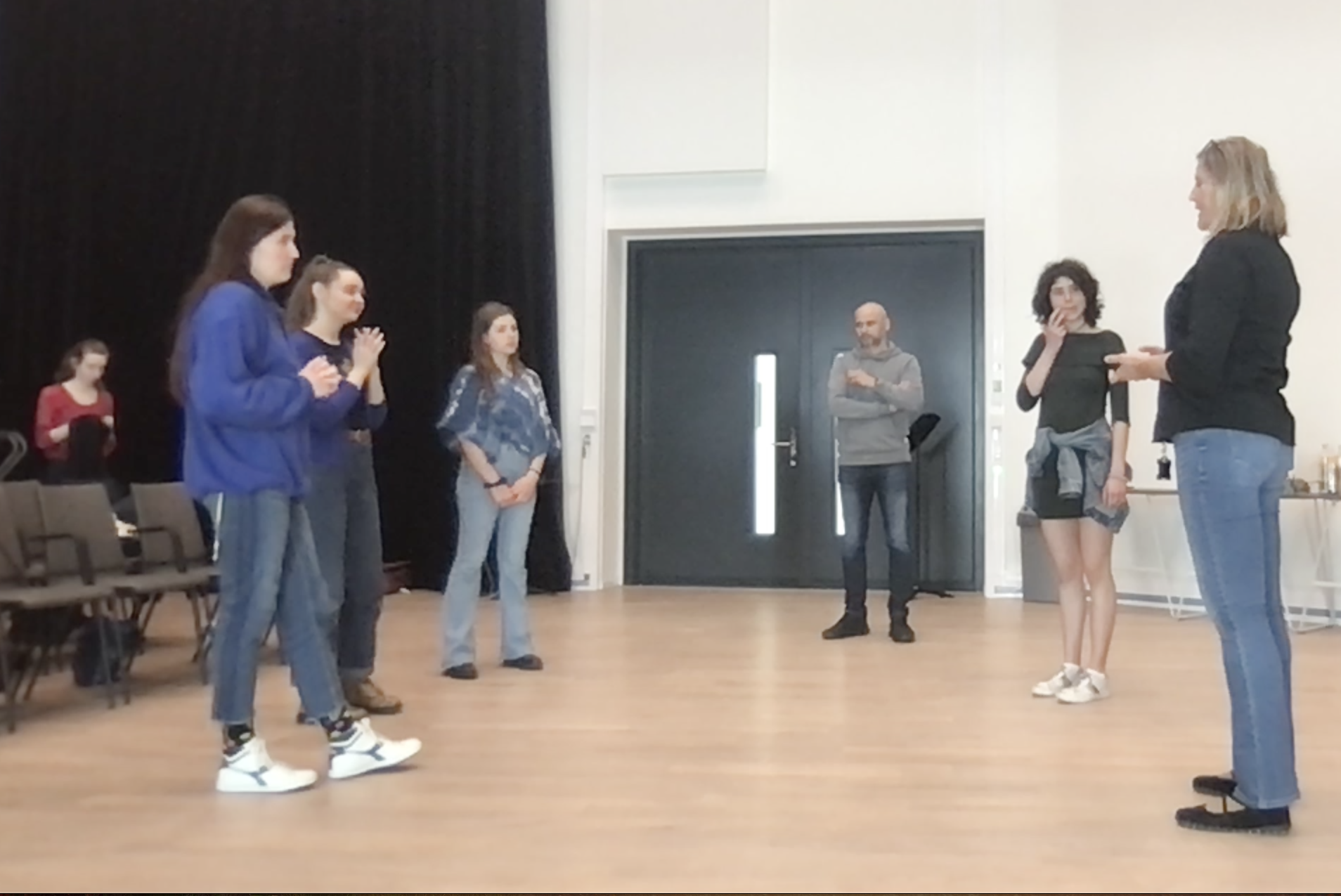
What was your experience through the entire process?
Do you think this sort of exercises are useful in improving one’s rhythm?
Did you notice any difference in your body (sound quality, muscle work, effort used for singing, shift of concentration) when singing the song before and after the physical exercises?
What is your approach to practising rhythm and timing?
How do you approach and work on challenging rhythmical passages in a song?
Is practising rhythm and time feel part of your practice routine?
For this case study we decided to work on a piece from the choir repertoire which was familiar and known to everyone, to eliminate the need to read new music and thus have an extra obstacle in performing the exercises. The task was to sing the song without any warm-up, paying attention to how it feels and sounds as is. Afterward, we introduced our rhythmic exercises which extended eventually to 3 layers (stomping, clapping/snapping fingers, singing), and at the end of the lesson performed the same piece once more to compare both takes.
The exercises included stamping beats 1 and 3, snapping fingers or clapping hands on beats 2 and 4 and singing. We were standing in a circle and used the mirroring technique, where the instructor is first to show the exercise and the students repeat after him/her and try to copy the rhythms and movements. We also took the time for impro games: everyone keeps the beat with stamping and snapping/clapping and improvised short 2-bar phrases creating various rhythmic patterns and ideas. We worked our way through the circle where each time one students would improvise pattern and the next student repeat it etc. The rhythmic material used for the exercises, mirroring and copying as well as the improvisation consisted mostly of quarter notes, eight notes and eight note triplets. The choice for this material was deliberate and in line with the rhythmic material used predominantly in the piece which was based in jazz and swing style.
Some reflections:
It was interesting to observe how the students were dealing with the various level of difficulty and with adding the layers of the rhythm. We could see that every student dealt with it differently and that the students were adapting quicker or slower based on their previous experience and practice of rhythm. The students that had more experience with the practice of rhythm also in another way than with the instrument only were adapting faster and were more fluent in the timing and phrasing. They also recognised the patterns quicker and could reproduce them faster. We could see that it was important to try to “let go” and activate more natural sense and feeling for the movement and rhythm without thinking too much about it.
Some of our observations and predictions were also confirmed by the student’s answers they filled in in the questionnaire.
Student 1 response:
-
I had a good time! I like the repetitiveness of the movements, it’s meditative. After a while the stepping becomes automatic and you stop thinking so much. I once heard somewhere that walking frees up space in your mind, so this is like two birds with one stone: calming down and learning the feel of rhythm.
-
I think these exercises are very useful to internalise rhythm. By repeating the steps again and again, you don’t have to think about it so much and you start feeling it better. Then you can build other layers on top of what you’re already doing but also easily return to the basics when you stumble over something.
-
I think I was more centred after the exercises, so my sound was probably a bit more stable. I was also more aware of the pulse of the rhythm, which likely helped with timing.
-
I usually listen to a recording I like many times and sing along until I can replicate the rhythm and timing. Sometimes I try tapping the beat if I can’t immediately feel or hear how something falls into the beat/rhythm.
-
Same as what I wrote at question four. I suppose I don’t practice specifically to improve rhythm and timing but just learn from the different songs I practice.
-
No, not really. I sometimes try to tap along when I hear a song with a particularly interesting rhythm or feel, but I don’t go out of my way to find material for practice.
Suggestions and comments: I noticed that this time went a lot more smoothly for me than the other time when we practiced rhythm with the ‘Oyele ma’ song. Maybe those rhythms were just more complicated, or this time we took more time to established that initial stepping and snapping-rhythm?
Student 2 response:
1.I thought it was a nice lesson/session. It was difficult for me, because rhythm is not my strongest suit and neither is improvising jazz. But the jazz choir lessons in general helped with exploring improvisation a bit, which was really nice.
The lesson helped with shifting focus from singing/melody to rhythm, to pay more attention to the rhythms we were singing and to pay closer attention to the way we were singing them. It was also good to incorporate a song that we all knew quite well and to compare the situation before and after working on the rhythm exercises.
2.I definitely believe that this kind of rhythm exercises/games help to improve rhythm and feel for rhythm. I have done quite a few rhythm games throughout the last few years (at music camp) and they helped me with a kind of independence between a melody and performing rhythms underneath. Another useful thing is that the games/exercises help with a certain ‘feel’ for rhythm and timing.
3.Before performing the exercises, I was mainly focussing my energy on singing the right tones, trying to fit in with the (sound of the) others etc. After performing the exercises, my focus shifted to the rhythms that I was singing. And timing them with more care. Basically, paying more attention to the rhythms in general. I felt that the choir as a whole was more together.
4.Being a classical singer, I don’t have to work on timing the same way that jazz singers do (I think). Something that I always find useful is writing the beat above a difficult rhythm. This way, I know where the beat is supposed to be and how the rhythm functions in the measure.
When I sing light music, I try to improve my timing by taking a song that I know, snapping/stepping on the beat and play a bit with timing of entrances or changing the rhythm here and there.
5.As said above, I write beat-stripes above the rhythm, to place the rhythm in the measure. Also, practicing it very slowly, to know and feel exactly what happens, and counting aloud. Another thing that helps me is to sometimes subdivide the rhythm into smaller note values. This helps me to know the rhythm very precisely. When I know it better, I count the beat, and speed up.
6.Not really. When singing light music more than when practicing my classical pieces. Unless I have a (modern) piece with difficult rhythmical parts.
Suggestions and comments: I think that some more variety in exercises would be nice. We took a long time in the circle repeating a motive of the previous improvisation and then making something of your own. I would like to have some more exercises/games to explore different kinds of approaching practicing rhythm/time feel.
Second workshop/case study:
In September 2022 during StartUp! week we had a chance to experiment with a group of twenty few first-year students from various departments of various instruments. For this session we designed the following plan:
• Playing a simple well-known melody together (“Twinkle Twinkle Little Star” - TTLS)
• Playing TTLS unison with different subdivisions clapped by instructors – quarter notes, eight-notes, eight-note triplets, sixteen-notes, and quarter note triplets.
• Dividing the students into groups and playing TTLS in two groups while each group has assigned a different rhythmic layer. Then swoping the layers in groups
• Playing the 2 layers simultaneously by each student
• Putting instruments away and starting the practice without the instruments
• Stomping half notes – quarter notes on the thigh to start with, change hands.
• We introduce 3rd layer (quarter notes triplet) but stop the second layer, change hands.
• Put everything together more and more frequent changes
• Introducing singing simple melody, aligned with one of the layers (probably half note to start with)
Taking instruments back and repeat the same exercises with playing the instruments.
Questions to the participants:
Is practising rhythm and time feel part of your practice routine? What is your approach to practising rhythm and timing? How do you approach and work on challenging rhythmical passages in a song?
Short reflection:
This resulted in much-improved version of the exercises and the rhythmic feel, which contributed to the improved musical version of the song. In this group, we had students from the jazz, classical, and early music departments. We could observe the differences in the execution of the exercises and noticed that the students from the jazz department seem to have less difficulty with the execution, especially the students that are playing instruments that are part of a rhythm section in the jazz group context such as drums, bass, piano or guitar. Also, students who already experimented with rhythm and timing/pulse practice in the past, had an advantage and were following the instructions with better results. However, we could see that within the time of our session the improvement was apparent in almost all participants. Their bodies seemed more relaxed, playing instruments became more fluent, some experienced a feeling of ‘more grounding’, some found the session beneficial for the sake of physical practise.
EXERCISES - DESCRIPTION AND VIDEOS
By observing random people reacting to music in the most spontaneous, subconscious manner (at a Glastonbury festival, at the New Year’s concert from Vienna, and selected performances from North Sea Jazz Festival), we determined that the simplest exercise and the starting point for our rhythmic exercises should be clapping hands (in 4/4 on the 1st and the 3rd or the 2nd and the 4th beat) and stomping feet (on the 1st and the 3rd beat).
The exercises are built gradually in difficulty to perform them successfully, adding challenges and layers combining rhythms, according to students’ abilities. They are designed to challenge habits and activate the whole body, resulting in new experiences of rhythmic layers and often polyrhythmic structures. To eliminate the necessity for reading during the sessions, we decided to work without any written material or sheet music. This way the students can fully focus on the feeling and immerse themselves in the process without any other influences and obstacles. It is important to us to direct the focus to inner feel and natural process, rather than reading music or any instructions from a screen or paper. We based our starting exercises on Peter Stavrum’s videos. More advanced, polyrhythmic exercises were designed based on the interview with Udo Dahmen and our experience from his interactive presentation at AEC conference in 2020 in Trondheim.
The exercises can be practiced individually, as well as in a group. Practicing in a group can be beneficial for various reasons:
• learning faster by mirroring others’ movements
• instant feedback from the group and/or the teacher
• learning by own and others’ mistakes (and realising that others also might have similar difficulties)
• weak points of ones are not emphasised, but rather compensated by others
• call and response, improvising together
All exercises presented here are performed in 4/2-time signature, but can be perceived also as 4/4 -time, depending on the tempo given.
Exercise 1
- Stamping on each beat, starting with the right foot
- Adding tapping hands on the beat, first right hand for four strokes, left hand four strokes
- Hands double the strokes – two on each beat, keeping the same number of beats, starting with the right hand followed by left
Go back to point 2 and continue switching between the two feels
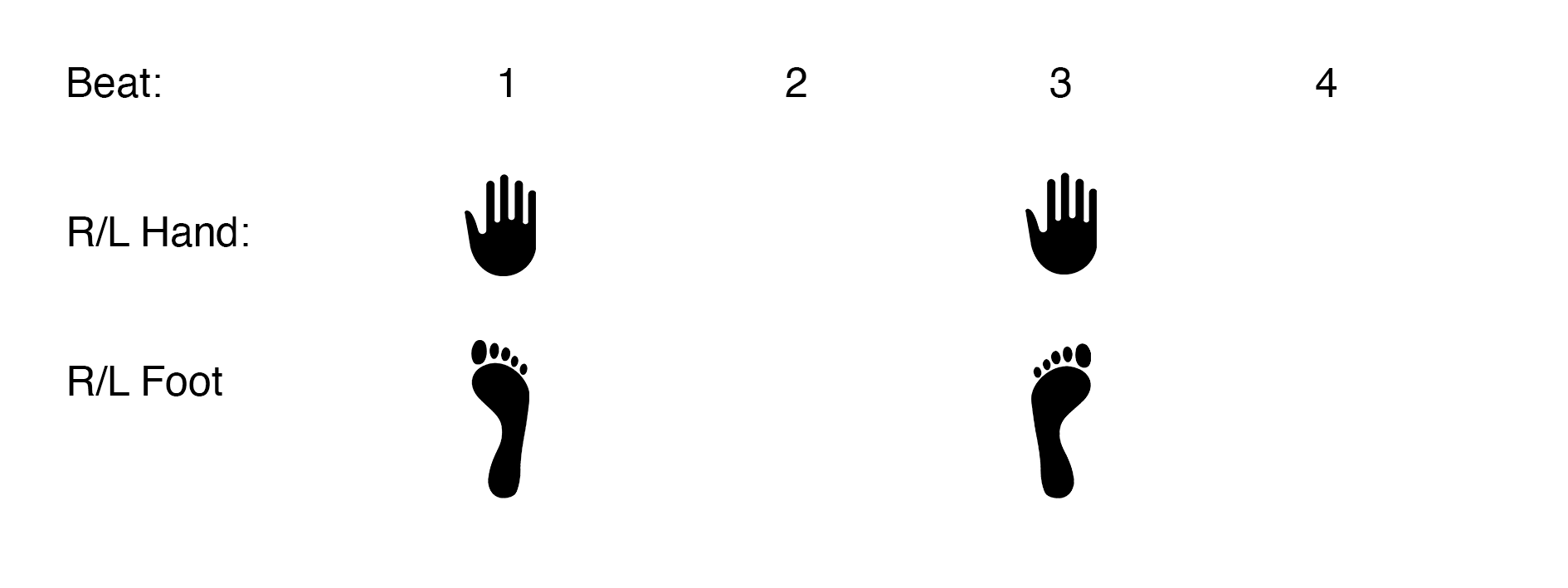
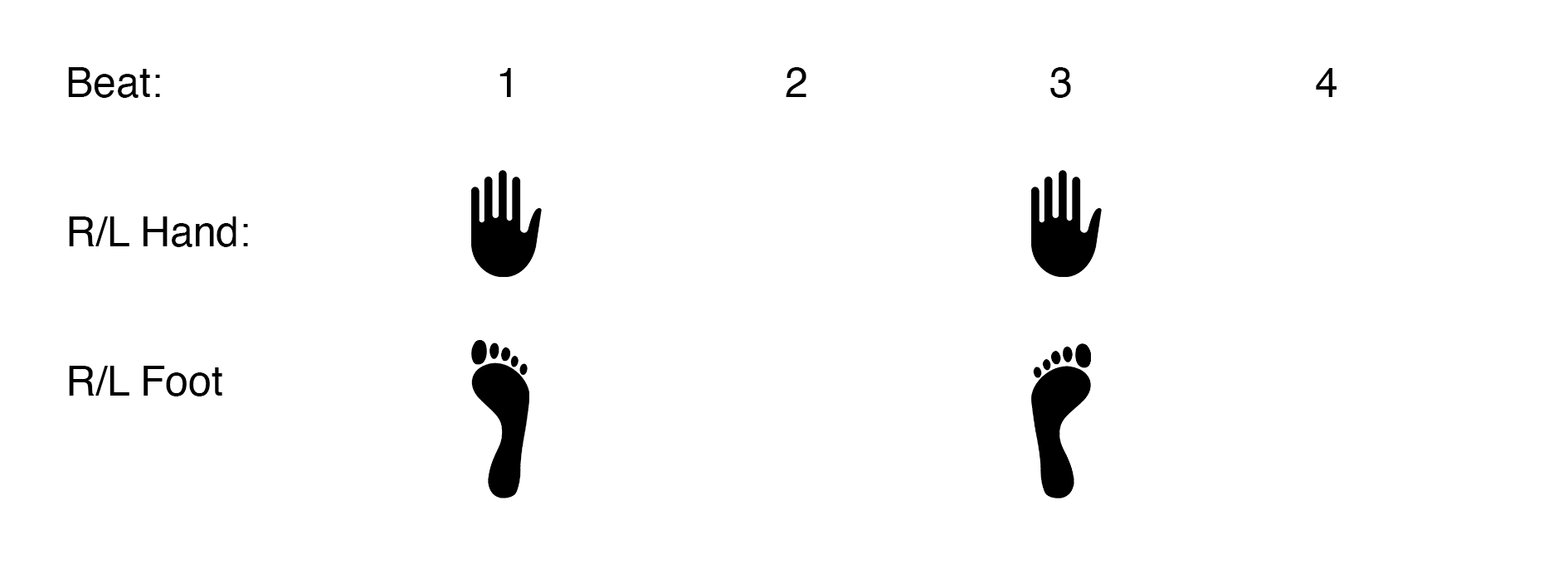
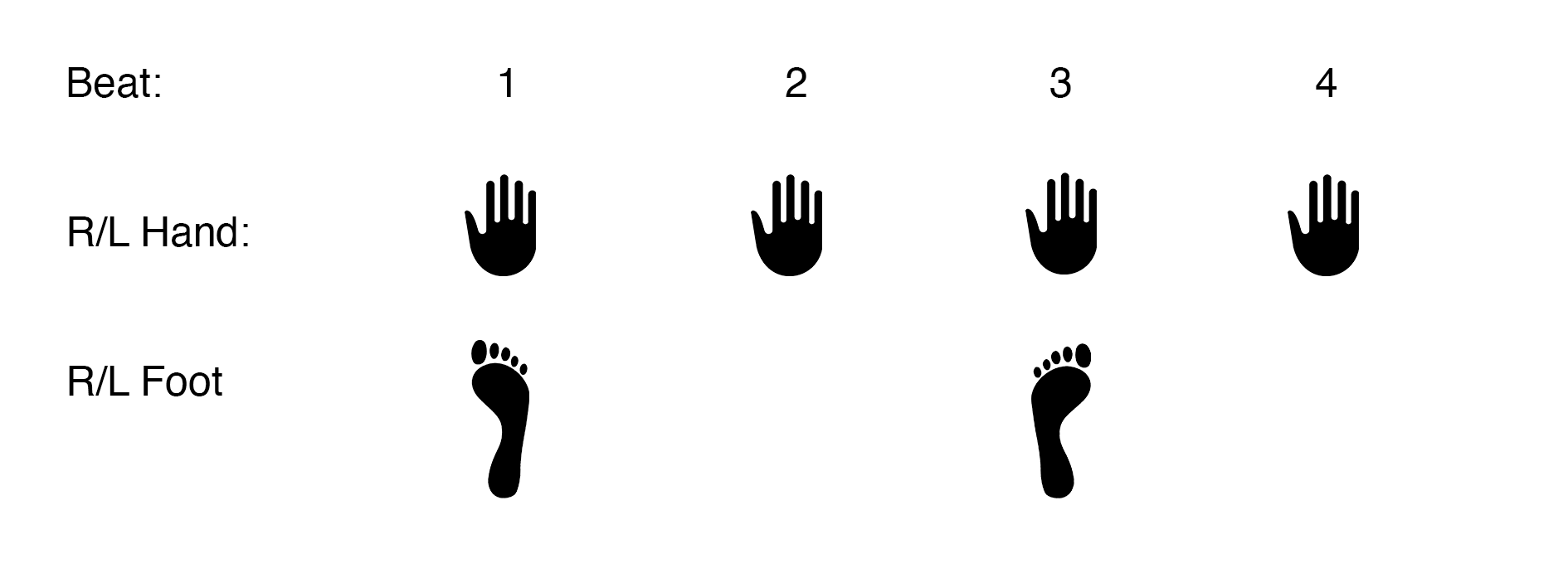

Exercise 2
- Stamping on each beat, starting with the right foot, hands are tapping
eight or quarter notes (depending on the perception of the time signature, in 4/4-time signature eight notes, in 4/2-time signature quarter notes), starting with the right hand - Hands change to three strokes per beat, keeping the same number of beats, starting with the right hand followed by left
Go back to point 1 and continue switching between the two feels


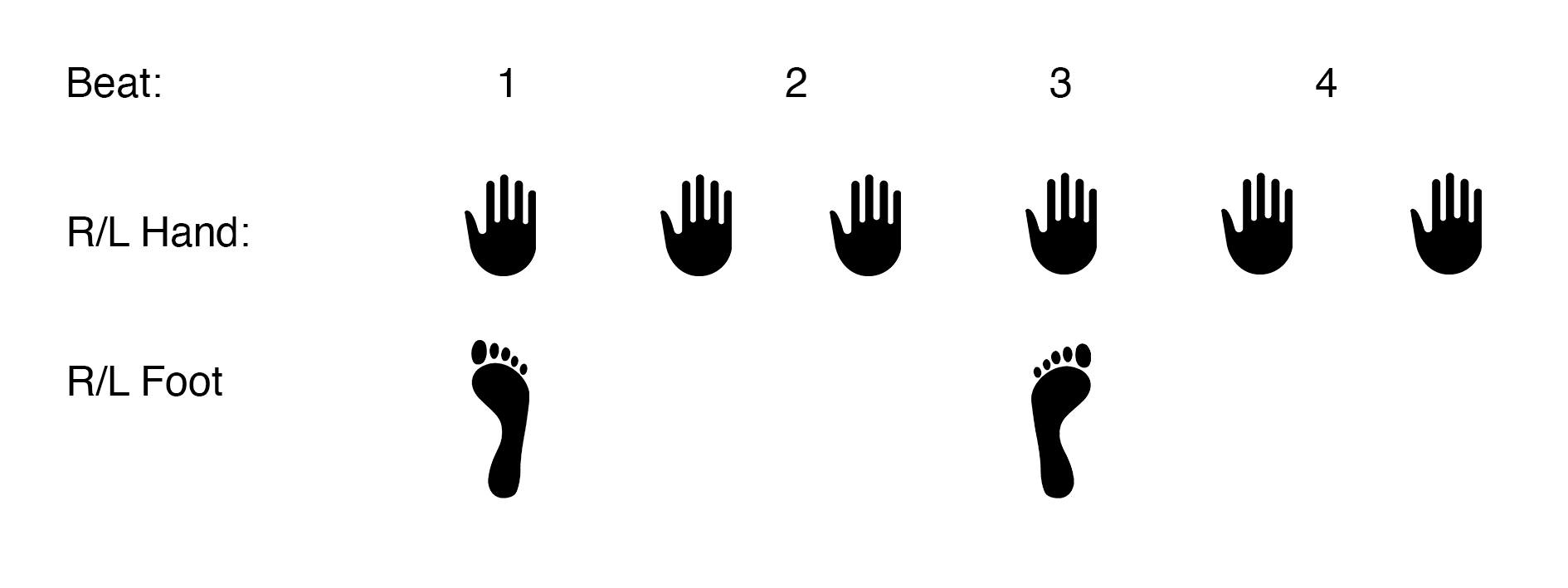

Exercise 3
- Stamping on each beat, starting with the left foot
- Adding tapping hands on the beat, first left hand for four strokes, right hand four strokes
- Hands double the strokes – two on each beat, keeping the same number of beats, starting with the left hand followed by right
Go back to point 2 and continue switching between the two feels
Exercise 4
In this video we demonstrate how the exercise number 1 can be performed when practiced in the duo or a group.
- One or more participants are performing exercise number 1 – starting with point 2 – stamping and tapping quarter or eight notes with the right hand, participant 2 is performing the exercise starting with point 3 simultaneously – stamping and tapping double the strokes – quarter or eight notes
- Alternating between point 2 and 3 by both participants or groups, never having together the same point
These videos are an example of two-layer exercises, that can be extended to three and four layers – using stamping, tapping of the hands on the upper legs, upper body, snapping fingers and singing or using vocal sounds. When done in groups or at least in duo setting, each group can be performing different tasks while the pulse should be the same, just as when playing together in a musical setting. In these videos we choose to demonstrate exercises that are based on 4/4- or 4/2-time signature, this can be also extended to any time signature desired for practice to improve the feel and pulse. Depending on the need, the exercises can be also designed to improve the rhythm and feel in a given piece from the repertoire or when studying a new composition. They will then use predominantly the rhythmic material used in the piece in the given time signature etc.
REFLECTIONS
The exercises that we tested with the students are designed to improve their overall skills in rhythm and timing/pulse, but they are not supposed serve as an end goal. When performed successfully they should be varied and extended to keep students challenged and engaged. We have noticed that when students can perform them successfully, they can repeat them another time without much difficulty and they seem to be internalised and understood in the body. Personally, we had similar response to them as well, it feels almost like riding a bike – once you can do it, you won’t forget it. We have noticed also that when the students focused more on controlling the movements from their “heads”, they struggled more than if they would just “let go”, immersed themselves in the “feeling” and let the pulsation of the body do it. In other words – the less they tried to have the control, the more natural and instinctive way of learning took over.
In both case studies we conducted a survey/questionnaire about participant’s experiences and about their practice of rhythm and timing in general. Our data shows that from twenty-odd students attending the workshop only three sometimes focus their practise on rhythm and timing in any way. All those students were from the jazz department. None of the students from the classical/vocal/early music departments were even considering practising rhythm a part from playing their pieces and dealing with necessary rhythmical obstacles given by the composition they wanted to perform.
Participants from the studies experienced improving their rhythm feel during the session and were very positive about the outcomes.
Our experience when introducing some of the exercises in our lessons have very similar effect on the students. They are starting to show progress and express more interest in alternative ways to practice rhythm and timing. Body movement exercises have an immediate effect also on vocal students, they improve their timing as well as the sound quality, sing with more energy, and are highly appreciated.